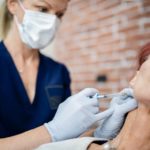Curious why we ask you to remove your make-up before treatments?
Quite simply, both your makeup and indeed your own skin are an infection risk. There is increasing evidence that the complications of dermal fillers that were once thought to be caused by our own immune system are in fact due to infection. The most likely time for introduction of infection is at the time of injection1,2.
Important: this information is for educational purposes only and not intended as medical direction. Always seek personalised, medical advice from your healthcare professional on matters relating to your health management.
Bacteria on Skin
It has been estimated that 30–50 million bacteria can be found on each square inch of human skin. The majority of these are normal, friendly microbes, and if they remain on the outside we have no problems. The skin and mucous membranes are the body’s protective barriers. Breaching these barriers (eg with a needle or a scalpel) can introduce those bacterial into the subcutaneous tissue, muscle, bone and body cavities.
We know that most surgical site infections originate from the patient’s own bacteria entering the wound at the time of surgery3. Dermal filler procedures involve multiple passes of a needle or cannula from skin to bone, so disinfection of the skin before the injection of a filler is absolutely crucial in reducing the risk of microbial contamination. If bacteria is introduced into the body with the dermal filler at the time of injection, it can use the filler substance as a food source and slowly multiply, potentially leading to the onset of lumps and hardening of the filler, and even to abscesses. Reducing the number of bacteria on the entire face, not just the site of injection, will reduce the risk of a patient developing an infection-related complication4,5,6,7.
We therefore need to thoroughly clean and disinfect your skin before and during your filler procedure. Logically, in order to do that we need to remove your makeup.
Bacteria in Makeup
Also, in addition to simply getting in the way, the makeup itself is potentially an infection hazard8. In a small study in 2015, items of out-of-date make-up were tested under strict laboratory conditions. All tested positive for enterococcus faecalis, a deadly strain of bacteria that can cause meningitis and septicaemia9. Other bacteria that were found growing in the make-up and their potential health risks include9:
- Ubacterium: causes bacterial vaginosis
- Aeromonas: one of the causes of gastroenteritis and wound infections
- Staphylococcus epidermidis: a bacterium which is resistant to antibiotics and can be deadly to people in hospital or who have catheters or surgical implants
- Propionibacterium: one of the main causes of acne and other skin conditions
- Enterobacter: causes urinary and respiratory tract infections
Make-up and photography
Makeup also interferes with our photography system – we can’t get reliable before and after photos when patients are wearing full contouring foundation, and the filters we use to highlight UV damage, vessels and wrinkles can’t see through the makeup.
Dermal Filler Treatments at SkinBox
As dermal filler procedures become more and more popular, and access to them easier and easier, we find ourselves increasingly reminding patients that these are not beautician treatments. The injection of a foreign substance (that is going to last for months/years) into your face is a medical procedure and it should be treated as such.
Patient safety and outcomes are our paramount concern and so yes, despite our patients finding it inconvenient at times, we will insist on total make-up removal and thorough skin disinfection prior to dermal filler procedures.
Thank you for your understanding, Dr. Sarah 🙂
References
1. De Boulle K, Heydenrych I. Patient factors influencing dermal filler complications: prevention, assessment, and treatment. Clin Cosmet Investig Dermatol. 2015;8(8):205–214.
2. King M, Bassett S, Davies E, King S. Management of Delayed Onset Nodules. J Clin Aesthet Dermatol. 2016;9(11):1–5.
3. Ayliffe GA. Role of the environment of the operating suite in surgical wound infections. Rev Infect Dis. 1991;13(Suppl 10):S800–804
4. Heydenrych I, Kapoor KM, De Boulle K. et al. A 10-point plan for avoiding hyaluronic acid dermal filler-related complications during facial aesthetic procedures and algorithms for management. Clin Cosmet Investig Dermatol. 2018 Nov 23;11:603-611
5. Signorini M, Liew S, Sundaram H. et al. Global Aesthetics Consensus: avoidance and management of complications from hyaluronic acid fillers—evidence and opinion-based review and consensus recommendations. Plast Reconstr Surg. 2016;137(6):961e–971e.
6. Wagner RD, Fakhro A, Cox JA, Izaddoost SA. Etiology, prevention, and management of infectious complications of dermal fillers. Semin Plast Surg. 2016;30(2):83–86.
7. Ferneini EM, Beauvais D, Aronin SI. An overview of infections associated with soft tissue facial fillers: identification, prevention, and treatment. J Oral Maxillofac Surg. 2017;75(1):160–166.
8. Collier H. Infection control in aesthetic medicine and the consequences of inaction. J Aesth Nursing 2018; 7(7): 352-361
9. Matewele P. Out of date make up can contain lethal bacteria, London Met scientist finds. 2015. https://tinyurl.com/ybuat6o5
